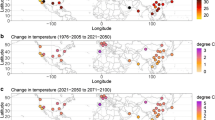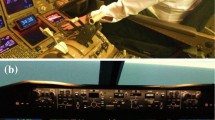Abstract
This paper provides fuel consumption analysis of an aircraft during climbing phases with gradual climb procedure. The analysis is based on BADA aircraft performance model and applied to an A320 aircraft climbing performance with varied true airspeeds optimal to the flight altitudes. The acceleration and angle of climb at specific altitudes were consequently varied with altitudes and calculated using numerical techniques. The comparisons of the fuel consumptions of continuous climbing with gradual reduced climb angle procedure and with constant climb angle procedure were presented. The results showed that the gradual climb procedure provides better fuel-saving by 8.1% of the climbing fuel compared to the continuous climb of constant climb angle procedure. It is suggested that the procedure can be improved with optimization of varied true airspeed, acceleration, angle of climb, and aircraft thrust.
Access provided by Autonomous University of Puebla. Download conference paper PDF
Similar content being viewed by others
Keywords
1 Introduction
Climate change becomes a very serious issue today as it has vast and strong impact on humanity securities. One of the major causes of this problem is CO2emission which largely produced from global aviation industry. To contribute on this concern, IATA issued a guidance material and best practices for fuel and environmental management (IATA, 2008) and issued a guidance material for sustainable aviation fuel management (IATA, 2015). A variety flight operation techniques for emission reduction were suggested such as engine out taxi, reduced takeoff flaps, reduced landing flaps, reduced acceleration altitude, optimum CG position, and continuous climb and continuous descent operation known as CCO and CDO.
For the past decades, there have been many researchers working and focusing on emission reduction during climbing and descending phases. Panklam and Kowanichkul (2011) performed flight simulation with RAMS PLUS software for A320 and B737 descending flights. It was found that with continuous descent operations, fuel consumption could be reduced 15.8% for A320 and 14.8% for B737 when descending from FL350. Ming et al. (2019) studied on fuel consumption of climbing phase of A320 aircraft based on flight data analysis. The continuous climb operation was simulated to climb from sea level to FL240 at standard temperature and with constant angle of climb. The results were compared with the flight of conventional climb procedure and show obviously that continuous climb operations provide fuel consumption reduction by 12.3%. Mori (2020) proposed a new fuel-saving climb procedure by reducing thrust near top of climb. 20–50 lbs of fuel could be saved for a large jet airliner.
2 Fuel Consumption Model
2.1 BADA Model
The calculation of fuel consumption and flight trajectory prediction in this study is based on the BADA aircraft performance model revision 3.8 (EUROCONTROL, 2010). The aircraft aerodynamics and fuel consumption model in the climbing phase are expressed as follows:
Total energy model
Rate of climb
Angle of climb
Lift coefficient
Drag coefficient
True airspeed (m/s)
Thrust specific fuel flow (kg/(min⋅kN)
Nominal fuel flow (kg/min)
Cruise fuel flow (kg/min)
2.2 Optimization and Numerical Models
The optimal true airspeed for gradual climb flight that varied with altitudes can be calculated from the lift coefficient which is determined from the optimization models (Anderson, 2014). The models are expressed as follows:
Lift coefficient for minimum thrust required
Lift coefficient for best range (jet propelled airplane)
The numerical model is formed for estimation of the acceleration of the aircraft and is given as follow:
2.3 Flight Simulation
In this study, climbing flights of three different cases were generated. These are continuous climb with constant angle of climb (CCO), gradual climb with minimum thrust required airspeed (GCO1), and gradual climb with best range airspeed (GCO2). All flights were simulated for A320 aircraft climbing from sea level to 24,000 ft. under the international standard atmosphere condition and at MTOW of 77,000 kg and then cruising to reach the distance of 120 km.
In gradual climb simulation, two different optimal airspeeds were examined, which are minimum thrust required airspeed and best range airspeed using Eqs. 10 and 11, respectively. The acceleration is then determined using Eq. 12 for altitude step of 1000 ft. Reduced thrust is applied with gradually reduced rate of 2% per 1000 ft. At every step of altitude, the aircraft mass is recalculated for the reduction due to fuel consumption. The flight trajectories of the studied cases were predicted and as shown in Fig. 1.
The fuel consumption model was validated with the calculation and the data analysis of Ming et al. (2019) for the case of continuous climb with constant angle of climb of 8 deg. The comparisons are shown in Table 1. The results of the present calculation model agree well with the reference model which has accuracy falling into 97.2%.
3 Results and Discussion
The calculation model for the flight trajectories of CCO, GCO1, and GCO2 was simulated and executed with a PC to give the climb distance, cruise distance, fuel flows during climb and cruise, and the total fuel consumption. The results are presented in Table 2.
The results in Table 2 show obviously that with gradual climb procedure, the fuel consumption is reduced when compared to the continuous climb procedure. The reduction of fuel consumption of GCO1 flight trajectory is 56.9 kg or 5.24%, while GCO2 flight trajectory provides even more fuel reduction of 91.5 kg or 8.43%. This agrees well with the works of Mori (2020).
4 Conclusion
The study of fuel consumption of aircraft flight with gradual climb procedure showed that the gradual climb procedure can improve fuel consumption up to 8.43%. To maximize fuel-saving, climbing with best range true airspeed is suggested. However, this suggestion should be further studied deeply to confirm the solutions. Actually, the optimization of the fuel consumption with gradual climb procedure is challenging as the fuel consumption of the climbing flight still has various variables to play with such as true airspeed, acceleration, angle of climb, and thrust of the aircraft, which can be written as in Eq. 13.
There are still a lot of works that can be done further on the development on the optimization with these variables.
Abbreviations
- CD0:
-
Zero lift drag coefficient
- CD2:
-
Induced drag factor
- Cf1:
-
1st thrust specific fuel consumption coefficient
- Cf2:
-
2nd thrust specific fuel consumption coefficient
- Fnom:
-
Nominal fuel flow [kg/min]
- g :
-
Gravitational acceleration [m/s2]
- m :
-
Aircraft mass [kg]
- THR:
-
Thrust [N]
- VTAS:
-
True airspeed [m/s] or [knots]
- γ :
-
Angle of climb [rad] or [deg]
- η :
-
Thrust specific fuel flow [kg/(min⋅kN)]
- ρ :
-
Air density [kg/m3]
References
Anderson, J. D. (2014). Introduction to flight (8th ed.). McGraw Hill.
EUROCONTROL. (2010). User Manual for Base of Aircraft Data (BADA) Revision 3.8. 2010; EEC Technical/Scientific Report No. 2010-003; Eurocontrol Experimental Centre; Les Bordes, France.
IATA. (2008). Guidance material and best practices for fuel and environmental management (3rd ed.). International Air Transport Association.
IATA. (2015). Guidance material for sustainable aviation fuel management (2nd ed.). International Air Transport Association.
Mori, R. (2020). Fuel-saving climb procedure by reduced thrust near top of climb. Journal of Aircraft, 57(5), 1.
Ming, Z., Qianwen, H., Sihan, L., & Yu, Z. (2019). Fuel consumption model of the climbing phase of departure aircraft based on flight data analysis. Sustainability, 11, 4362. https://doi.org/10.3390/su11164362
Panklam, P., & Kowanichkul, L. (2011). Fuel consumption calculation of flight procedures and time saving analysis. B.Sci. in Aviation Technology Thesis, Faculty of Engineering, Kasetsart University.
Author information
Authors and Affiliations
Corresponding author
Editor information
Editors and Affiliations
Rights and permissions
Copyright information
© 2023 The Author(s), under exclusive license to Springer Nature Switzerland AG
About this paper
Cite this paper
Atipan, S., Chomdej, P. (2023). Fuel Consumption Analysis of Gradual Climb Procedure with Varied Climb Angle and Airspeed. In: Karakoc, T.H., Atipan, S., Dalkiran, A., Ercan, A.H., Kongsamutr, N., Sripawadkul, V. (eds) Research Developments in Sustainable Aviation. ISSASARES 2021. Sustainable Aviation. Springer, Cham. https://doi.org/10.1007/978-3-031-37943-7_42
Download citation
DOI: https://doi.org/10.1007/978-3-031-37943-7_42
Published:
Publisher Name: Springer, Cham
Print ISBN: 978-3-031-37942-0
Online ISBN: 978-3-031-37943-7
eBook Packages: EnergyEnergy (R0)





